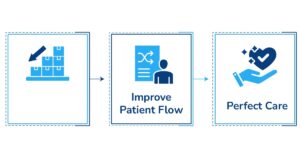The Lean Healthcare principles that apply to medical billing include the wastage minimization process and the enhancement of its operations. Some of them are billing synchronization, the use of electronic health records to enable the transfer of data, and value stream mapping to establish hurdles. It is because by minimizing data duplicates, automating insurance checks, and automating claim submission. Healthcare organizations can minimize claim rejections and maximize the speed of their revenue cycles.
Similarly ,the idea is to bring changes in the billing system to help both the healthcare providers and the patients in terms of time and inaccuracy. Here in this guide, you gain information about the principles, benefits, and lean model in healthcare!
Lean Healthcare in Medical Billing
Lean healthcare involves using the lean concept in organizations, particularly health facilities, to eliminate waste in every activity as part of the continuous improvement process. It is practiced at the hospital, where clinicians, operations, and administration staff work to find ways to eradicate waste within the healthcare system and add value for patients.
Additionally, having identified the need to look for sustainable ways of managing the projected growth in national health expenditures at 5.5% per year, the healthcare industry members. For more details about lean healthcare procedure, you may simply email us or contact us at MAVA Care.
Lean Principles in Healthcare
Lean principles and concepts in healthcare are not just about process improvement, it is also about a culture change that takes place in an organization. Here are the following principles for a lean healthcare system.
- Lean leadership in the health sector is essential to supporting the effective implementation of the principles in this area and ensuring that these changes are continuously followed.
- Two critical assumptions in implementing the lean philosophy are identifying waste and eliminating it. Waste may arise from overproduction, such as needlessly dispensing services or extensive patient testing.
- The lean model in healthcare is a strong framework for improving healthcare processes. Organizations can use it to achieve efficient patient flow, inventory demand management, and resource management.
- Quality improvement is a cornerstone of lean in healthcare. It is central to determining patient safety, care delivery outcomes, and organizational performance.
Benefits of the Lean Model in Healthcare
Applying Lean in the healthcare context frees an organization from delivering any processes that do not create or support value for patients. This results in improved population health status of the population in question. So, using Lean management principles, hospitals can:
- High patient satisfaction.
- Improve management
- Low infection process.
- Reduce wait times
- overtime work.
- Smooth paperwork.
Healthcare Lean Management
Healthcare Lean Management, therefore, refers to a management strategy that seeks to enhance efficiency in healthcare organizations. Like in manufacturing, Lean Management in healthcare focuses on eradicating waste, defining work, and continually improving processes to improve the value delivered to patients. Thus, it reduces expenses and increases organizational efficiency.
- Health Care Lean Management streamlines process and reduces waste.
- It tries to increase the efficiency of healthcare institutions.
- Applying manufacturing business concepts.
- Attempts to eliminate tasks that bring little value.
- Focuses on process standardization and continuous improvement.
- Aim to improve patient care while lowering expenses.
- Improves resource efficiency and quality.
- Patient-centered treatment is prioritized to enhance outcomes.
Procedure and Lean Methodology in Healthcare

1. Minimize the inventory
Reduced inventory is a cost that relates to both stored and capital resources. Unnecessary products and medicines, excessive equipment, unnecessary information, or unnecessary stocks of preprinted forms are all inventories. Therefore, holding too much stock increases the probability of it being stolen or obsolete. There are always ways to reduce it, and employees of the organization at any level can be trained to spot excessive inventory.
2. Improve Patient Flow
Carrying patients around the different wards and scrambling to get equipment also exposes the patient or caregiver to the danger of injury defect waste. It reduces the time that is expected to be used to deliver quality services (waiting for waste).
In addition, lean thinking may be applied to identifying inefficiencies in patient and caregiver mobility in the hospital facility to reduce injury risks, time wastage, and patient circulation.
3. Perfect Care
In healthcare, defect waste comprises process or breakdowns, medical errors, and misinterpretation. Examples of defect waste in healthcare include Healthcare-acquired conditions.
Moreover, it include blood clots and infections, medication or surgery site errors, avoidable readmissions, incorrect or missing allergic reactions, and imperfections in medical records.
Lean Healthcare Processing in Hospitals
Here are the following strategies that you can apply for smooth lean processing in hospitals. It includes:
1-Focus
Implementing lean processing in the framework of hospital activity is a way of stating a mission that is comprehensible to patients and forms the basis of decision-making. It was about specifying aims that involved nurturing and sustaining patient health safety and eliminating waste.
Likewise, when the processes in all the hospital departments are linked to a central goal, such as patient satisfaction or a better method of providing care, all the activities achieve the hospital’s objectives.
2-Complete Procedure
Lean processing concentrates on process activities that should be followed to avoid waste and enhance performance. It involves trying to understand and chart organizational processes to identify areas where unnecessary steps slow them down. Moreover, it means that in hospitals and many other fields, some processes, like the patient intake or discharge process, can be introduced as standards to avoid mistakes.
3-Folk Involvement
Lean processing in hospitals cannot be successful without the active involvement of the people who make the system work. This strategy emphasizes empowering all staff, from physicians to frontline workers, to identify issues and suggest improvements. It promotes teamwork. Hospitals foster a culture where everyone feels responsible for optimizing processes.
Six Sigma in Healthcare
The Six Sigma methodology aims to minimize defects to 0.0009966 percent of all possible outcomes. This methodology is widely used in manufacturing industries, where process standardization can also enhance process reliability.
Besides, many approaches exist to make healthcare management easier. Handling patients—especially those with unstable health conditions—cannot be a formal process and must remain fluid. Some of the components of Six Sigma, such as the DMAIC process, are incorporated into implementing a lean healthcare system.
Lean Healthcare Examples
Here are the examples of the lean model in healthcare:
- Standardized work processes that decrease variation and increase efficiency. Applying visual control systems to monitor the work process and analyze opportunities for improvement.
- Applying value stream mapping to identify and redesign patient care processes.
- Involving frontline staff in problem-solving and quality improvement activities.
- Decreasing patients’ waiting time and increasing their satisfaction and application of process improvement.
- Improving the actual and effective communication between healthcare teams to guarantee efficient patient care delivery.
- A culture to support and sustain improvement in the delivery of health care services.
Final Thoughts
Lean Healthcare in medical billing is important in enhancing revenue cycle management and operations. It cuts costs by doing away with inefficiencies, saves time in reimbursement, and improves cash flow.
Moreover, healthcare institutions would, therefore, benefit from the application of standard operating procedures and continuous improvement techniques in reducing the incidence of claim denials, the accented administrative expenses and improving patient experiences.
Therefore, lean principles assist in eliminating constraints that cause bottlenecks, increasing staff efficiency and meeting legislative requirements.
For more information and details, you can email us or give us a call at MAVA Care. We’ll be there to help you and handle all your billing and coding-related tasks.
FAQ’s
What are the 5 steps of lean in healthcare?
Here are the five steps that include:
- Determine Cost
- Chart the Stream of Revenue
- Establish Flow
- Determine the Pull
- Strive for Excellence
What does lean mean in healthcare?
Lean in healthcare is a concept that involves a structured and methodical approach towards the elimination of risk factors based on evidence from lean manufacturing methodology for quality patient care at the right time. It entails efficient resource management, process simplification, and improvement.
What are the 4 rules of lean?
The four rules of lean are:
1. Specify quality from the end
2. user’s perspective.
3. Locate and eliminate waste throughout the value flow.
4. Create flow by making processes smooth and continuous.
5. Establish pull by responding to customer demand.
Why lean in healthcare is important?
The adoption of lean in healthcare systems is crucial because it can increase value and improve patient satisfaction and health while decreasing expenses and errors. It allows healthcare organizations to realize value for patients, enhance resource use, and promote sustainable improvement.









